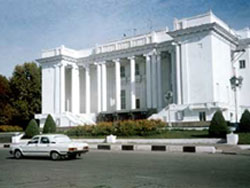Makhdumi Azam Mausoleum

Makhdumi Azam Mausoleum dates back to the XV-XVI centuries. Originally, the monument consisted of a small square gurkhan and greater ziarathany. Later in the south hall was fixed up a cross-shaped in plan, blocked by a monumental dome with the portal entrance. Thus, it turned out a building of strong architectural forms, but devoid of any decoration.
Makhdumi Azam is translated as greatest master and is not a name, but rather a title or nickname. The interesting thing is that in the territory of CentralAsia, there are several complexes under the same name, which is associated with different, existed, people, government or religious figures. Who exactly is buried in the Hissar mausoleum is anybody’s guess, and this is in prospect of researchers to determine, although in this regard there are already some versions and assumptions.
Dushanbe - Sights of Interest
- Ayni Academic Opera and Ballet Theater
- Shah Mansur Bazaar
- Ferdowsi National Library
- Hissar Fortress
- Makhdumi Azam Mausoleum
- Sangin Mosque
- Bekhzod Museum of Regional History and Fine Art
- Tajik Museum of Ethnography
- Abu Ali ibn Sina (Avicenna) Monument
- Sadradin Aini Monument
- Rudaki Monument
- Ozodlik (Freedom) Square
- Rohat Chaikhana